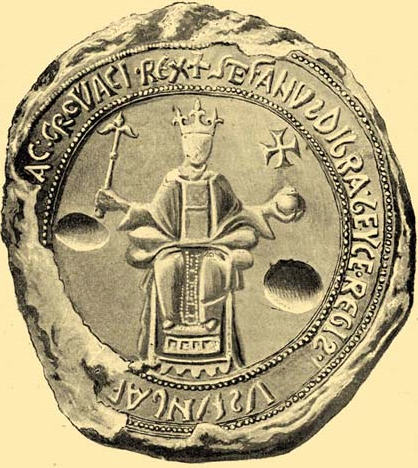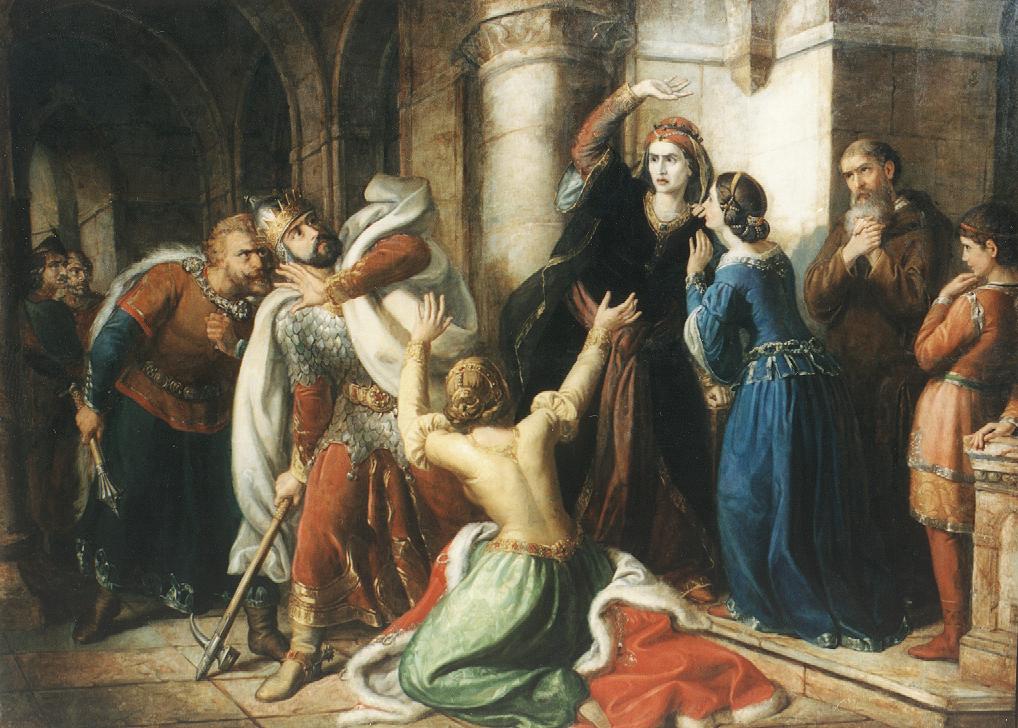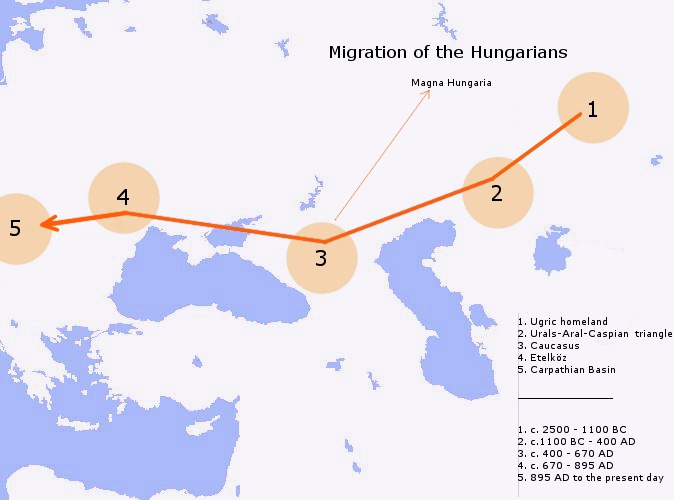|
Brothers' Quarrel (Hungary)
The Brothers' Quarrel () was a war of succession within the Árpád dynasty between Emeric, the King of Hungary, and his younger brother, Andrew, Duke of Slavonia. It lasted from 1197 to 1203, covering almost the entire reign of Emeric. The conflict had a significant impact on the development of the 13th-century society and political system in the Kingdom of Hungary. Background The illustrious Béla III ruled Hungary from 1172 to 1196. His first wife was Agnes of Antioch, the mother of all of his children. Their first child, a boy named Emeric, was born in 1174. Andrew, the second son of Béla III and Agnes, was born around 1177. Béla and Agnes had two other sons, Solomon and Stephen. One of them was still alive in early 1198. In order to ensure the uninterrupted succession to the Hungarian throne, Béla III decided to crown his eldest son during his lifetime. Emeric was crowned king while still a child by Nicholas, Archbishop of Esztergom, on 16 May 1182. This method was ... [...More Info...] [...Related Items...] OR: [Wikipedia] [Google] [Baidu] [Amazon] |
Mór Than
Mór Than (; 19 June 1828 – 11 March 1899) was a Hungarian painter. He painted in the Realist school and worked with several high-profile Hungarian and Austrian painters of his time. He travelled around Italy, in France and his native Hungary. Later in life, he worked for several museums and galleries in Hungary. Biography Born at Óbecse (today Bečej, Serbia) to his father János Than of Abbot (1789–1858), a royal treasurer, and mother Ottilia Setényi. He attended high school in Kalocsa, in present-day Hungary and then studied philosophy and law in the current-day Budapest. He became a student of painting under Miklós Barabás. His studies were interrupted, and during the 1848 revolution he became a war painter alongside Arthur Görgei. Later, due to illness, he was not conscripted into the imperial army. As a lawyer, he drew an entire album filled with objects drawn from Hungarian history, and after the conflict, he pursued an artistic career. He traveled ... [...More Info...] [...Related Items...] OR: [Wikipedia] [Google] [Baidu] [Amazon] |
Vejte Csanád
Vejte (I) from the kindred Csanád (; died after 1200) was a Hungarian lord, who served as Judge royal between 1199 and 1200, during the reign of Emeric, King of Hungary.Markó 2006, p. 276. Vejte (also Wetich or Vetuk) was born into the Csanád clan which originated from Csanád, who defeated provincial lord Ajtony, an enemy of Stephen I of Hungary in the early 11th century. Vejte had three sons. Theodore was the Palatine of Hungary in 1222; Vejte (II) married Lucia, the daughter of Pousa Bár-Kalán; and Ladislaus, who served as ''ispán'' of Csanád County in 1234.Zsoldos 2011, p. 146. He was first mentioned as ''ispán'' of Csanád County in 1199.Zsoldos 2011, p. 145. Beside the position of Judge royal, he also served as ''ispán'' of Nyitra County Nyitra County (; ; ; ) was an administrative county ( comitatus) of the Kingdom of Hungary. Its territory lay in what is now western Slovakia. Geography Nyitra County shared borders with the Austrian land Moravia and Trenc ... [...More Info...] [...Related Items...] OR: [Wikipedia] [Google] [Baidu] [Amazon] |
Stephen II Of Hungary
Stephen II (; ; ; 1101 – early 1131), King of Hungary and King of Croatia, Croatia, ruled from 1116 until 1131. His father, King Coloman, had him crowned as a child, thus denying the crown to his uncle Álmos, Duke of Croatia, Álmos. In the first year of his reign, Republic of Venice, Venice occupied Dalmatia and Stephen never restored his rule in that province. His reign was characterized by frequent wars with neighbouring countries. Early years (till 1116) Stephen and his twin brother, Ladislaus, were sons of the Hungarian king Coloman, King of Hungary, Coloman by his wife, Felicia of Sicily. According to the ''Illuminated Chronicle'', they were born "... in the year of our Lord 1101." Stephen was named after the Stephen I of Hungary, first king of Hungary, who had been canonized in 1083, implying that he was his father's heir from birth. A document written in Zadar in approximately 1105 AD makes mention of "Stephen, our most renowned king" along with Coloman, proving th ... [...More Info...] [...Related Items...] OR: [Wikipedia] [Google] [Baidu] [Amazon] |
Solomon, King Of Hungary
Solomon, also Salomon (; 1053–1087) was King of Hungary from 1063. Being the elder son of Andrew I, he was crowned king in his father's lifetime in 1057 or 1058. However, he was forced to flee from Hungary after his uncle, Béla I, dethroned Andrew in 1060. Assisted by German troops, Solomon returned and was again crowned king in 1063. On this occasion he married Judith, sister of Henry IV, Holy Roman Emperor. In the following year he reached an agreement with his cousins, the three sons of Béla I. Géza, Ladislaus and Lampert acknowledged Solomon's rule, but in exchange received one-third of the kingdom as a separate duchy. In the following years, Solomon and his cousins jointly fought against the Czechs, the Cumans and other enemies of the kingdom. Their relationship deteriorated in the early 1070s and Géza rebelled against him. Solomon could only maintain his rule in a small zone along the western frontiers of Hungary after his defeat in the Battle of Mogyoród on 14 Ma ... [...More Info...] [...Related Items...] OR: [Wikipedia] [Google] [Baidu] [Amazon] |
Nicholas, Archbishop Of Esztergom
Nicholas () was a 12th-century prelate in the Kingdom of Hungary. He was Archbishop of Esztergom between 1181 and 1183, and Bishop of Várad (now Oradea in Romania) from 1163 to 1181. Head of the royal chapel The earliest record of Nicholas – a charter of grant of Géza II of Hungary to the Óbuda Chapter – refers to him as the head of the royal chapel in 1148. He is the first leader of the royal chapel whose name was recorded. The royal chapel was an important office of the royal administration. Being the head of the royal chaplains, Nicholas signed at least four royal charters between 1148 and about 1157. For instance, he appears as the attestor (''sigillator'') of the last will and testament of lady Margaret in Pannonhalma (an important source of 12th-century Hungarian economic history) in 1152. He was styled as count (''ispán'') of the royal chapel (, ) between around 1156 and 1158, when Géza confirmed a land donation to the Garamszentbenedek Abbey (today Hronský ... [...More Info...] [...Related Items...] OR: [Wikipedia] [Google] [Baidu] [Amazon] |
Agnes Of Antioch
Agnes of Antioch ( 1154 – c. 1184), also known as Anna of Antioch and Anne de Châtillon, was Queen of Hungary from 1172 until 1184 as the first wife of Béla III. The accidental discovery of her intact tomb during the Hungarian Revolution of 1848 provided an opportunity for patriotic demonstrations. She was the only 12th-century Hungarian queen whose remains were studied by scientists, and her appearance was reconstructed. Life She was the daughter of Raynald of Châtillon and Constance, Princess of Antioch. The exact date of her birth is uncertain. It is assumed that she was born soon after the secret marriage of her parents, which took place before May 1153. The most common belief in historiography was that Agnes was born in 1154. At the baptism she probably received the name of Agnes. Early life and marriage Her father was captured by the Muslims in November 1160 and was confined in Aleppo for the next fifteen years. Agnes's mother Princess Constance died c. 1163/67, a ... [...More Info...] [...Related Items...] OR: [Wikipedia] [Google] [Baidu] [Amazon] |
Béla III Of Hungary
Béla III (, , ; 114823 April 1196) was King of Hungary and King of Croatia, Croatia between 1172 and 1196. He was the second son of King Géza II of Hungary, Géza II and Géza's wife, Euphrosyne of Kiev. Around 1161, Géza granted Béla a duchy, which included Croatia in the union with Hungary, Croatia, central Dalmatia and possibly Sirmium. In accordance with a peace treaty between his elder brother, Stephen III of Hungary, Stephen III, who succeeded their father in 1162, and the Byzantine Emperor Manuel I Komnenos, Béla moved to Constantinople in 1163. He was renamed to Alexios, and the emperor granted him the newly created senior Byzantine aristocracy and bureaucracy, court title of ''despotes''. He was betrothed to the Emperor's daughter, Maria Komnene (daughter of Manuel I), Maria. Béla's patrimony caused armed conflicts between the Byzantine Empire and the Kingdom of Hungary between 1164 and 1167, because Stephen III attempted to hinder the Byzantines from taking contr ... [...More Info...] [...Related Items...] OR: [Wikipedia] [Google] [Baidu] [Amazon] |
Árpád Dynasty
The Árpád dynasty consisted of the members of the royal House of Árpád (), also known as Árpáds (, ). They were the ruling dynasty of the Principality of Hungary in the 9th and 10th centuries and of the Kingdom of Hungary from 1000 to 1301. The dynasty was named after the Hungarian Grand Prince Árpád who was the head of the Hungarian tribal federation during the conquest of the Carpathian Basin, c. 895. Previously, it was referred to as the Turul dynasty or kindred. Both the first Grand Prince of the Hungarians (Álmos) and the first king of Hungary (Saint Stephen) were members of the dynasty. Christianity was adopted as the state religion for the Kingdom of Hungary by the dynasty, and the Árpád's kings used the title of the apostolic king, the descendants of the dynasty gave the world the highest number of saints and blesseds from one family. The Árpád dynasty ruled the Carpathian Basin for four hundred years, influencing almost all of Europe through its ... [...More Info...] [...Related Items...] OR: [Wikipedia] [Google] [Baidu] [Amazon] |
War Of Succession
A war of succession is a war prompted by a succession crisis in which two or more individuals claim to be the Order of succession, rightful successor to a demise of the Crown, deceased or deposition (politics), deposed monarch. The rivals are typically supported by Political faction, factions within the Court (royal), royal court. Foreign powers sometimes Interventionism (politics)#Foreign interventionism, intervene, alliance, allying themselves with a faction. This may widen the war into one between those powers. Wars of succession were some of the most prevalent types of Casus belli#Categorisation, wars by cause throughout human history, but the replacement of absolute monarchy, absolute monarchies by an international order based on democracy with constitutional monarchy, constitutional monarchies or republics ended almost all such wars by 1900. Terminology Descriptions In historiography and literature, a ''war of succession'' may also be referred to as a ''succession ... [...More Info...] [...Related Items...] OR: [Wikipedia] [Google] [Baidu] [Amazon] |
Martin Hont-Pázmány
Martin from the kindred Hont-Pázmány (; died between 1236 and 1245) was a Hungarian influential lord in the Kingdom of Hungary, who served as Judge royal in 1214, during the reign of Andrew II of Hungary. He was born into the Hont-Pázmány kindred of German ancestry, founded by knights Hont and Pázmány in the late 10th century. His father was Vajk, he had also two brothers.Markó 2006, p. 282. Martin was a loyal supporter of Duke Andrew, who rebelled against the realm of his brother, King Emeric at several times. In contemporary records, he was first mentioned as ''ispán'' of Szolnok County in 1201.Zsoldos 2011, p. 209. He was appointed Ban of Slavonia in 1202, when his lord Andrew held the royal title of Duke of Slavonia.Zsoldos 2011, p. 42. Martin served as ''ispán'' of Vas County from 1203 to 1206.Zsoldos 2011, p. 222. Following the sudden death of the child Ladislaus III, his uncle Andrew II ascended the throne in 1205. According to the charters, Martin functione ... [...More Info...] [...Related Items...] OR: [Wikipedia] [Google] [Baidu] [Amazon] |
Nicholas, Palatine Of Hungary
Nicholas (; died after 1215) was an influential Hungarian lord in the Kingdom of Hungary, who served as Palatine of Hungary twice during the reign of Andrew II of Hungary. Identification His origin is uncertain: according to a royal charter issued in 1233, he had a namesake son, who held the office of Master of the treasury from 1231 to 1235.Zsoldos 2011, p. 334. Thus it is excluded with absolute certainty that Palatine Nicholas was identical with Nicholas Szák, Nicholas Csák or Nicholas, brother of Mojs I, all of whom were barons of Andrew II during that time.Zsoldos 2011, p. 333. Career In contemporary records, Nicholas was first mentioned as Ban of Slavonia in 1200, when Andrew, the brother of King Emeric held the royal title of Duke of Slavonia, therefore can be assumed that Nicholas was a loyal supporter of Andrew, who rebelled against the rule of his brother several times.Zsoldos 2011, p. 42. According to László Markó and former archontological works, Nicholas also s ... [...More Info...] [...Related Items...] OR: [Wikipedia] [Google] [Baidu] [Amazon] |
Elvin (bishop Of Várad)
Elvin (also ''Elvinus''; died after 1200) was a Hungarian prelate in the late 12th century, who served as Bishop of Várad (present-day Oradea, Romania) from 1189 to 1200. Background Elvin was born into a wealthy and prominent family, but his parentage and origin is unknown. He had a brother (or at least, relative; ''frater'') Boleslaus, also a prelate, who served as Bishop of Vác from 1193 to 1212. They also had another unidentified brother, the father of certain Othmar and Marhard. Based on the geographical location of their landholdings, historian Vince Bunyitay considered that both of them belonged to the ''gens'' (clan) Becsegergely. Early 19th-century historian János Bárdosy claimed both Boleslaus and Elvin were the sons of Both (also Bot or Bat), the ''ispán'' of Bihar County. Elvin possessed estates around the episcopal see Várad. He had a palace in Micske in Bihar County (today part of Chișlaz, Romania). He also possessed five vineyards in Bihar (present-day ... [...More Info...] [...Related Items...] OR: [Wikipedia] [Google] [Baidu] [Amazon] |



